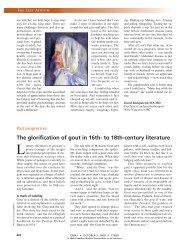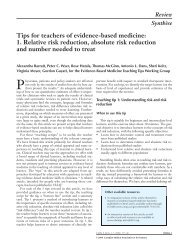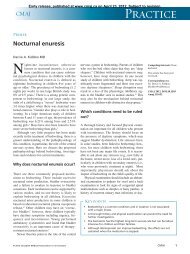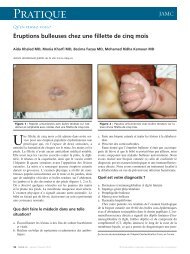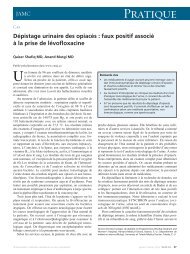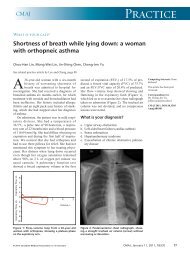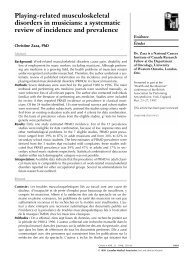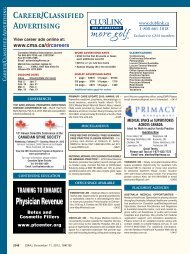Nonuse of bicycle helmets and risk of fatal head injury: a ...
Nonuse of bicycle helmets and risk of fatal head injury: a ...
Nonuse of bicycle helmets and risk of fatal head injury: a ...
You also want an ePaper? Increase the reach of your titles
YUMPU automatically turns print PDFs into web optimized ePapers that Google loves.
CMAJ<br />
<strong>Nonuse</strong> <strong>of</strong> <strong>bicycle</strong> <strong>helmets</strong> <strong>and</strong> <strong>risk</strong> <strong>of</strong> <strong>fatal</strong> <strong>head</strong> <strong>injury</strong>:<br />
a proportional mortality, case–control study<br />
Navindra Persaud MD MSc, Emily Coleman BA, Dorothy Zwolakowski BA, Bert Lauwers MD, Dan Cass MD<br />
One cyclist dies in Canada each week, <strong>and</strong><br />
cycling <strong>fatal</strong>ities account for more than<br />
2% <strong>of</strong> traffc <strong>fatal</strong>ities, a leading cause <strong>of</strong><br />
death in young adults. 1 Cycling safety regulations<br />
vary by jurisdiction, <strong>and</strong> controversy remains<br />
about the effectiveness <strong>of</strong> safety measures such as<br />
<strong>helmets</strong>. There is strong evidence that <strong>helmets</strong><br />
prevent non<strong>fatal</strong> <strong>head</strong> injuries, 2 but very limited<br />
evidence exists related to <strong>fatal</strong> <strong>head</strong> injuries. A<br />
meta-analysis <strong>of</strong> case–control studies showed a<br />
protective effect <strong>of</strong> <strong>helmets</strong> against <strong>head</strong> injuries,<br />
but it was based on just 4 case <strong>fatal</strong>ities in which<br />
<strong>helmets</strong> were not worn. 3 An other large study<br />
involving 1710 cycling collisions found a trend<br />
toward a protective effect <strong>of</strong> <strong>helmets</strong>, but included<br />
only 14 <strong>fatal</strong>ities. 4 The existing literature leaves<br />
open the possibility that <strong>helmets</strong> prevent non<strong>fatal</strong><br />
<strong>head</strong> injuries, but not <strong>fatal</strong> ones.<br />
We sought to determine whether cycling without<br />
a helmet was associated with an increased<br />
<strong>risk</strong> <strong>of</strong> sustaining a <strong>fatal</strong> <strong>head</strong> <strong>injury</strong>.<br />
Methods<br />
Early release, published at www.cmaj.ca on October 15, 2012. Subject to revision.<br />
Abstract<br />
Background: The effectiveness <strong>of</strong> <strong>helmets</strong> at<br />
preventing cycling <strong>fatal</strong>ities, a leading cause<br />
<strong>of</strong> death among young adults worldwide, is<br />
controversial, <strong>and</strong> safety regulations for<br />
cycling vary by jurisdiction. We sought to<br />
determine whether nonuse <strong>of</strong> <strong>helmets</strong> is associated<br />
with an increased <strong>risk</strong> <strong>of</strong> <strong>fatal</strong> <strong>head</strong><br />
<strong>injury</strong>.<br />
Methods: We used a case–control design<br />
involving 129 <strong>fatal</strong>ities using data from a<br />
coroner’s review <strong>of</strong> cycling deaths in Ontario,<br />
Canada, between 2006 <strong>and</strong> 2010. We defined<br />
cases as cyclists who died as a result <strong>of</strong> <strong>head</strong><br />
injuries; we defined controls as cyclists who<br />
died as a result <strong>of</strong> other injuries. The exposure<br />
variable was nonuse <strong>of</strong> a <strong>bicycle</strong> helmet.<br />
Study population<br />
We used a proportional mortality, case–control<br />
design using data from a coroner’s review <strong>of</strong><br />
cycling <strong>fatal</strong>ities in Ontario, Canada. The review<br />
was conducted by the Offce <strong>of</strong> the Chief Coro-<br />
Results: Not wearing a helmet while cycling<br />
was associated with an increased <strong>risk</strong> <strong>of</strong> dying<br />
as a result <strong>of</strong> sustaining a <strong>head</strong> <strong>injury</strong> (ad -<br />
justed odds ratio [OR] 3.1, 95% confidence<br />
interval [CI] 1.3–7.3). We saw the same relationship<br />
when we excluded people younger<br />
than 18 years from the analysis (adjusted OR<br />
3.5, 95% CI 1.4–8.5) <strong>and</strong> when we used a<br />
more stringent case definition (i.e., only a<br />
<strong>head</strong> <strong>injury</strong> with no other sub stantial injuries;<br />
adjusted OR 3.6, 95% CI 1.2–10.2).<br />
Interpretation: Not wearing a helmet while<br />
cycling is associated with an increased <strong>risk</strong> <strong>of</strong><br />
sustaining a <strong>fatal</strong> <strong>head</strong> <strong>injury</strong>. Policy changes<br />
<strong>and</strong> educational programs that increase the use<br />
<strong>of</strong> <strong>helmets</strong> while cycling may prevent deaths.<br />
ner for Ontario <strong>and</strong> involved all accidental<br />
cycling deaths occurring in the province between<br />
January 2006 <strong>and</strong> December 2010. 5 According to<br />
Ontario’s Coroners Act, all deaths that are sudden<br />
<strong>and</strong> unexpected, or from any cause other<br />
than disease, must be reported to a coroner.<br />
We reviewed the reports <strong>of</strong> the investigating<br />
coroner, police incident reports <strong>and</strong> accident<br />
reconstruction reports. We used a st<strong>and</strong>ardized<br />
computerized form for data abstraction, including<br />
the age <strong>and</strong> sex <strong>of</strong> the cyclist <strong>and</strong> driver (or pedestrian,<br />
for incidents between cyclists <strong>and</strong> pedestrians),<br />
the mechanism <strong>of</strong> death, the results <strong>of</strong> postmortem<br />
examination, the cause <strong>of</strong> death, the<br />
clothing worn by the cyclist, helmet use <strong>and</strong> the<br />
use <strong>of</strong> <strong>bicycle</strong> safety equipment, such as lights.<br />
Statistical analysis<br />
We defned cases as <strong>fatal</strong>ities included in the<br />
coroner’s review for which the cause <strong>of</strong> death<br />
was a <strong>head</strong> <strong>injury</strong> (including traumatic <strong>head</strong><br />
<strong>injury</strong>, closed <strong>head</strong> <strong>injury</strong>, craniocerebral trauma<br />
<strong>and</strong> similar terms); we defned controls as <strong>fatal</strong>ities<br />
for which the cause <strong>of</strong> death was not a <strong>head</strong><br />
<strong>injury</strong>. We calculated odds ratios [ORs], correcting<br />
for age <strong>and</strong> sex using logistic regression. Our<br />
prespecifed test was for an association between<br />
<strong>risk</strong> <strong>of</strong> death from a <strong>fatal</strong> <strong>head</strong> <strong>injury</strong> <strong>and</strong> not<br />
wearing a helmet. No data were missing.<br />
Research<br />
Competing interests: None<br />
declared.<br />
This article has been peer<br />
reviewed.<br />
Correspondence to:<br />
Navindra Persaud,<br />
nav.persaud@utoronto.ca<br />
CMAJ 2012. DOI:10.1503<br />
/cmaj .120988<br />
© 2012 Canadian Medical Association or its licensors CMAJ 1
Research<br />
2 CMAJ<br />
Results<br />
There were 129 accidental cycling deaths<br />
between Jan. 1, 2006, <strong>and</strong> Dec. 31, 2010. Decedents<br />
ranged in age from 10 to 83 years, <strong>and</strong> most<br />
<strong>of</strong> them were boys or men (86%, 111/129) (Ta -<br />
ble 1). Most collisions (77%, 99/129) involved a<br />
motor vehicle (Table 2).<br />
Table 1: Characteristics <strong>of</strong> cases <strong>and</strong> controls<br />
Characteristic<br />
Cases*<br />
n = 71<br />
Controls<br />
n = 58<br />
Males, no. (%) 60 (84) 51 (88)<br />
Age, mean ± SD<br />
Age, yr<br />
43 ± 21 41 ± 19<br />
< 18 10 (14) 6 (10)<br />
18–29 12 (17) 10 (17)<br />
30–39 5 (7) 7 (12)<br />
40–49 17 (24) 15 (26)<br />
50–59 9 (13) 7 (12)<br />
60–69 9 (13) 10 (17)<br />
> 69 9 (13) 3 (5)<br />
Note: SD = st<strong>and</strong>ard deviation.<br />
*Cause <strong>of</strong> death was a <strong>head</strong> <strong>injury</strong>.<br />
Table 2: Types <strong>of</strong> incidents leading to injuries <strong>of</strong> cases <strong>and</strong> controls<br />
Type <strong>of</strong> incident<br />
Cases, no. (%)*<br />
n = 71<br />
Controls, no. (%)<br />
n = 58<br />
Collision with motor vehicle 55 (77) 44 (76)<br />
Collision with other <strong>bicycle</strong> 2 (3) 0 (0)<br />
Collision with pedestrian 1 (1) 0 (0)<br />
Collision with other object 5 (7) 7 (12)<br />
No collision (fall) 8 (11) 7 (12)<br />
*Cause <strong>of</strong> death was a <strong>head</strong> <strong>injury</strong>.<br />
Table 3: Odds <strong>of</strong> death from a <strong>head</strong> <strong>injury</strong> when not wearing a helmet<br />
while cycling, with <strong>and</strong> without other substantial injuries<br />
Fraction not<br />
wearing a helmet<br />
Case definition Cases Controls OR (95% CI)<br />
Head <strong>injury</strong> as<br />
cause <strong>of</strong> death<br />
with other<br />
injuries<br />
Head <strong>injury</strong> as<br />
cause <strong>of</strong> death<br />
with no other<br />
injuries<br />
Note: CI = confidence interval, OR = odds ratio.<br />
*Adjusted for age <strong>and</strong> sex.<br />
Adjusted*<br />
OR (95% CI)<br />
58/71 37/58 2.5 (1.2–5.7) 3.1 (1.3–7.3)<br />
38/43 57/86 3.9 (1.4–10.9) 3.6 (1.2–10.2)<br />
Death due to a <strong>head</strong> <strong>injury</strong> (with or without<br />
other substantial injuries) showed a signifcant<br />
association with not wearing a helmet while<br />
cycling (Table 3). A similar relationship was seen<br />
if only adults (age 18 yr <strong>and</strong> older) were considered<br />
(OR 2.87, 95% confdence interval [CI] 1.2–<br />
6.4; adjusted OR 3.5, 95% CI 1.4–8.5). The odds<br />
were similar when a more stringent case defnition<br />
was used: <strong>head</strong> <strong>injury</strong> as cause <strong>of</strong> death with<br />
no other substantial injuries.<br />
Using a less conservative control defnition <strong>of</strong><br />
only incidents in which the cyclist was run over<br />
(<strong>and</strong> therefore where death could not have been<br />
prevented by wearing a helmet), the control<br />
prevalence <strong>of</strong> not wearing a helmet was 47%<br />
(7/15; OR 7.1, 95% CI 2.0–28).<br />
Interpretation<br />
In this case–control study involving 129<br />
cycling deaths, we saw an association between<br />
dying as a result <strong>of</strong> sustaining a <strong>head</strong> <strong>injury</strong><br />
<strong>and</strong> not wearing a helmet. These results are<br />
consistent with a protective effect <strong>of</strong> <strong>helmets</strong><br />
on cycling deaths.<br />
The OR we calculated for helmet use is similar<br />
to those calculated from studies <strong>of</strong> helmet<br />
use in non<strong>fatal</strong> collisions that employed methods<br />
similar to ours. 6–9 Thompson <strong>and</strong> colleagues<br />
6 reviewed 3390 cyclists presenting to<br />
emergency departments in Seattle, Washington,<br />
for injuries sustained in crashes. They defned<br />
cases as cyclists who sustained brain injuries,<br />
whereas controls were defned as cyclists who<br />
sustained any other injuries. They found that<br />
cases (29%) were less likely to have been wearing<br />
<strong>helmets</strong> than controls (56%) (OR 3.2, 95%<br />
CI 2.7–3.8). These fndings <strong>and</strong> ours are consistent<br />
with a meta-analysis that found a <strong>risk</strong><br />
reduction <strong>of</strong> 65% for non<strong>fatal</strong> <strong>head</strong> injuries<br />
with the use <strong>of</strong> <strong>helmets</strong>. 2<br />
The enactment <strong>of</strong> legislation promoting helmet<br />
use is associated with an increase in helmet<br />
use <strong>and</strong> a decrease in <strong>head</strong> injuries. 10 For example,<br />
in Victoria, Australia, helmet use increased<br />
from 31% to 75%, <strong>and</strong> cycling <strong>fatal</strong>ities<br />
decreased by 48%, after the introduction <strong>of</strong><br />
m<strong>and</strong>atory helmet laws, despite an increase in<br />
cycling among adults. 11 In Canada, wearing <strong>helmets</strong><br />
is more common in provinces with m<strong>and</strong>atory<br />
helmet laws. 12<br />
Limitations<br />
Our analysis is dependent on helmet use being<br />
reported similarly regardless <strong>of</strong> the cause <strong>of</strong><br />
death. The similarity between helmet use in the<br />
control group (36%) <strong>and</strong> that reported in the<br />
Canadian Community Health Survey 12 (34%) is
consistent with the group <strong>of</strong> cycling <strong>fatal</strong>ities<br />
involving injuries other than <strong>head</strong> injuries being<br />
an appropriate control, <strong>and</strong> suggests that helmet<br />
use was not underreported for controls.<br />
The OR we calculated may underestimate the<br />
<strong>risk</strong> <strong>of</strong> a <strong>fatal</strong> <strong>head</strong> <strong>injury</strong> when a helmet is not<br />
worn for several reasons. The control group may<br />
have included some cyclists who died because<br />
they were not wearing a helmet (i.e., cyclists<br />
who may have survived their other injuries if<br />
they had not also sustained a <strong>head</strong> <strong>injury</strong>),<br />
which would increase the prevalence <strong>of</strong> not<br />
wearing a helmet among control <strong>fatal</strong>ities. Furthermore,<br />
<strong>helmets</strong> may not have been worn<br />
properly or been in working order at the time <strong>of</strong><br />
the collision; we were unable to determine the<br />
type or status <strong>of</strong> the <strong>helmets</strong> worn. In addition,<br />
the OR we calculated would underestimate the<br />
<strong>risk</strong> <strong>of</strong> not wearing a helmet if cyclists who do<br />
not wear <strong>helmets</strong> are more likely to be involved<br />
in <strong>fatal</strong> collisions, because this tendency would<br />
increase the number <strong>of</strong> cyclists not wearing a<br />
helmet in both the case <strong>and</strong> control groups,<br />
thereby lessening the difference between<br />
groups.<br />
Classifcation bias in determining cause <strong>of</strong> death<br />
is unlikely, because the cause <strong>of</strong> death was determined<br />
by coroners using a complete list <strong>of</strong> injuries<br />
before the start <strong>of</strong> our study. The lack <strong>of</strong> bias is supported<br />
by the same association as the primary<br />
analysis being found when the more stringent case<br />
defnition (i.e., the only <strong>injury</strong> was a <strong>head</strong> <strong>injury</strong>)<br />
was used.<br />
Conclusion<br />
Policies <strong>and</strong> campaigns that promote helmet<br />
use may decrease cycling mortality, which contributes<br />
substantially to mortality among young<br />
adults worldwide. Concomitant educational programs<br />
<strong>and</strong> public awareness campaigns may<br />
account for some <strong>of</strong> the positive effects <strong>of</strong> enacting<br />
helmet legislation. Cyclists less than 18 years<br />
<strong>of</strong> age are required by law to wear a helmet in<br />
Ontario. That 88% <strong>of</strong> decedents in our study<br />
were older than 18 years (<strong>and</strong> 18% were > 60 yr)<br />
suggests a gap in public policy.<br />
References<br />
1. Ramage-Morin PL. Motor vehicle accident deaths, 1979–2004.<br />
Health Rep 2008;19:45-51.<br />
2. Thompson DC, Rivara FP, Thompson R. Helmets for preventing<br />
<strong>head</strong> <strong>and</strong> facial injuries in cyclists. Cochrane Database Systematic<br />
Rev 2000;(2):CD001855.<br />
3. Attewell RG, Glase K, McFadden M. Bicycle helmet effcacy: a<br />
meta-analysis. Accid Anal Prev 2001;33:345-52.<br />
4. McDermott FT, Lane JC, Brazenor GA, et al. The effectiveness<br />
<strong>of</strong> bicyclist <strong>helmets</strong>: a study <strong>of</strong> 1710 casualties. J Trauma 1993;<br />
34: 834-44.<br />
5. Offce <strong>of</strong> the Chief Coroner for Ontario. Cycling death review,<br />
June 2012. Available: www .mcscs .jus .gov .on .ca /stellent /groups<br />
/public /@mcscs /@www /@com /documents /webasset /ec159773<br />
.pdf (accessed 2012 Oct. 2).<br />
6. Thompson DC, Rivara FP, Thompson RS. Effectiveness <strong>of</strong> <strong>bicycle</strong><br />
safety <strong>helmets</strong> in preventing <strong>head</strong> injuries. A case–control<br />
study. JAMA 1996;276:1968-73.<br />
7. Thomas S, Acton C, Nixon J, et al. Effectiveness <strong>of</strong> <strong>bicycle</strong> <strong>helmets</strong><br />
in preventing <strong>head</strong> <strong>injury</strong> in children: case–control study.<br />
BMJ 1994;308:173-6.<br />
8. Thompson RS, Rivara FP, Thompson DC. A case–control study<br />
<strong>of</strong> the effectiveness <strong>of</strong> <strong>bicycle</strong> safety <strong>helmets</strong>. N Engl J Med<br />
1989; 320:1361-7.<br />
9. McDermott FT, Lane JC, Brazenor GA, et al. The effectiveness<br />
<strong>of</strong> bicyclist <strong>helmets</strong>: a study <strong>of</strong> 1710 casualties. J Trauma 1993;<br />
34: 844-5.<br />
10. Macpherson A, Spinks A. Bicycle helmet legislation for the<br />
uptake <strong>of</strong> helmet use <strong>and</strong> prevention <strong>of</strong> <strong>head</strong> injuries. Cochrane<br />
Database Syst Rev 2008;(3):CD005401 10.<br />
11. Cameron MH, Vulcan AP, Finch CF, et al. M<strong>and</strong>atory <strong>bicycle</strong><br />
helmet use following a decade <strong>of</strong> voluntary promotion in Victoria,<br />
Australia — an evaluation. Accid Anal Prev 1994;26:325-37.<br />
12. Bicycle helmet use, 2009. Ottawa (ON): Statistics Canada; 2009.<br />
Available: www.statcan.gc.ca/pub/82-625-x /2010002 /article<br />
/11274 -eng.htm (accessed 2012 Aug. 31).<br />
Affiliations: From the Offce <strong>of</strong> the Chief Coroner for Ontario<br />
(Persaud, Coleman, Zwolakowski, Lauwers, Cass), Toronto,<br />
Ont.; Keenan Research Centre, (Persaud) Li Ka Shing Knowledge<br />
Institute, St. Michael’s Hospital; the Department <strong>of</strong> Family<br />
<strong>and</strong> Community Medicine, St. Michael’s Hospital, University<br />
<strong>of</strong> Toronto, Toronto, Ont.; the Department <strong>of</strong> Family <strong>and</strong><br />
Community (Lauwers), Medicine <strong>of</strong> McMaster University,<br />
Hamilton, Ont.; <strong>and</strong> the Division <strong>of</strong> Emergency Medicine<br />
(Cass), the University <strong>of</strong> Toronto, Toronto, Ont.<br />
Contributors: Bert Lauwers <strong>and</strong> Dan Cass oversaw the<br />
coroner’s review; Navindra Persaud conceived <strong>of</strong> this study;<br />
Emily Coleman, Dorothy Zwolakowski <strong>and</strong> Navindra Persaud<br />
analyzed the data; Navindra Persaud wrote the frst draft<br />
<strong>of</strong> the manuscript; Emily Coleman, Dorothy Zwolakowski,<br />
Bert Lauwers <strong>and</strong> Dan Cass revised the manuscript critically<br />
for important intellectual content. All <strong>of</strong> the authors approved<br />
the fnal version <strong>of</strong> the manuscript submitted for publication.<br />
Acknowledgements: The authors thank Dr. David Evans for<br />
assistance with data collection <strong>and</strong> analysis. Navindra Persaud<br />
is funded by a Banting Postdoctoral Fellowship from<br />
the Canadian Institutes <strong>of</strong> Health Research <strong>and</strong> by the<br />
Department <strong>of</strong> Family <strong>and</strong> Community Medicine at St.<br />
Micheal’s Hospital, Toronto, Ont.<br />
Research<br />
CMAJ 3



